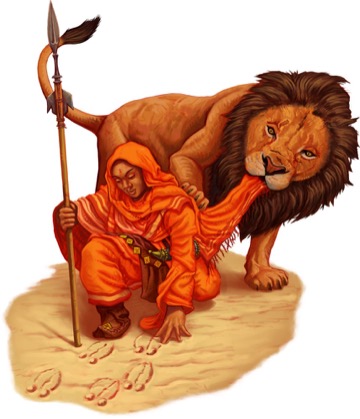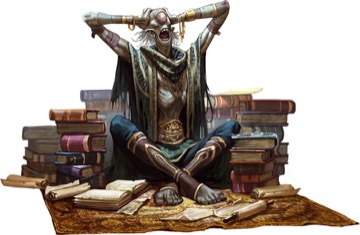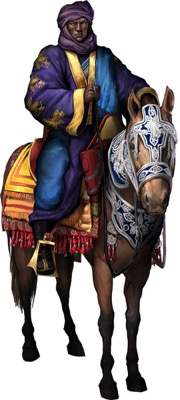| Kajehase |
| 1 person marked this as a favorite. |
Dragon78 wrote:What movie/book reference?I assume he means the title of the blog post, which is a ref to The Sound of Music.
He's going to haaaaaaate it when my next blog post is titled "How do you solve a problem like Qadira?" }:-)
You're making sure you won't throw away your shot.
| Cthulhudrew |
| 1 person marked this as a favorite. |
It's probably limited to blogs for now.
Let's hope not. Maybe some enterprising folk out there will use it in some other products- Wayfinder articles, or NPCs in Adventure Paths, or in some of the Pathfinder Tales products (if I were an enterprising writer and someone had just done a bunch of the linguistic work for me, I know I'd certainly ask permission to include it!)
 Snorter
Snorter
|
| 2 people marked this as a favorite. |
Let's hope not. Maybe some enterprising folk out there will use it in some other products- Wayfinder articles, or NPCs in Adventure Paths, or in some of the Pathfinder Tales products (if I were an enterprising writer and someone had just done a bunch of the linguistic work for me, I know I'd certainly ask permission to include it!)
Wayfinder 10 covered Qadira and surrounding area, so it may be a while before we revisit it, except in issues with a worldwide theme (I'm very interested in what this book does with desert fey).
If you haven't already downloaded WF 10, do it now (do it, doo eeet...).
There's a lot to use in that issue, there's even have a foreword by Wolfgang Baur, author of TSR's 'Al-Qadim' setting.
Issue 16 is almost out (the Numeria issue), issue 17 will be a celebration of the last 10 APs (which are light on desert action), so issue 18 would be the earliest you could see any specifically Qadiran articles. So if you want to petition the team for that theme, you could do so now.
Why not write something yourself, once you've read this new book?
 Snorter
Snorter
|
While I did not appreciate the movie/book reference (ugh! Cannot stand them.), I do like the potential of Sunlight/Fire bardic performance and Solar Sorcerer Bloodline.
Wanna know why we keep starting fires?
JUMP ON THE PYRE!JUMP ON THE PYRE!
Fire in the dune sea.
Fire in the dune sea.
Set fire to the earth and sky.
Fire in the dune sea.
Fire in the dune sea.
Fire in the... caravanserai!
doodle-e-do-doo do do do-do-doo
doodle-e-do-doo do do do-do-doo
 Rysky
Rysky
|
| 8 people marked this as a favorite. |
For those wanting to favourite the Blog post in all it's glory :3
Qadira: These Are a Few of My Favorite Things
Friday, January 6, 2017Very soon, dear readers, copies of Qadira: Jewel of the East will be in your hands (or available to be in your hands, if you're not a subscriber), so this seems like an excellent time to list off my ten favorite things about Qadira and/or this book. Behold:
1. The "Adventuring In Qadira" section: These 24 pages of mysteries, perils, ancient secrets, and general weirdness give glimpses of locations like the razor-edged obsidian labyrinth of the Lady of the Burnt Lands; Ihalar, a massive underground city; Ushumgal, a banking center probably run by bronze dragons; the deadly ruins of Qumarin, from which explorers emerge blinded, their faces branded with wheels of wings, eyes, and fire; and the Tower of Winds, set among a sea of colorful grasses haunted by strange beings who ask visitors a single question to which there is no correct answer. There's also a lot more detail about sites we've mentioned before, like the harpy-haunted ruins of Al-Bashir, the military training grounds of Omash, and the twisted gnoll settlement of Shadun.
2. My favorite piece of art ever: Look at this gloriousness. It's the adventurer equivalent of having your cat sleeping on your keyboard when you need to get work done. The poor lady just wants to figure out where these tracks go, and her lion animal companion is demanding that she play with him NOW.
[insert glorius kitty pic here]
Illustration by Lance Red3. John Compton's patronage system: In Qadira, getting ahead is all about who you know and what they can do for you. John has put together a brilliant system for navigating the currents of Qadiran society, gaining access to the elite, and benefitting from your connections.
4. Keleshite ethnicities: Did you think "Keleshite" described a single culture or people? If you did, that's understandable—that's what most people from Avistan think, too. But the Padishah Empire of Kelesh is home to many different peoples and cultures, making "Keleshite" more of an umbrella term, like "Avistani" or "Tian," than a specific ethnicity like "Ulfen" or "Shoanti." Learn about the six major cultures that formed the Empire, as well as close to a dozen ethnic minorities common in Qadira. There are also details about how non-humans and different classes fit into Qadiran society, from tieflings pretending to be emberkin aasimars to Paraheen dwarf weaponsmiths, and Taldan brawlers to the pyrokineticists of the Imperial Forces.
5. This other piece of art, which is also my favorite piece of art ever: It's a CYCLOPS WITH A MIGRAINE. I empathize so much, buddy.
[insert awesome Cyclops with migraine pic here]
Illustration by Eric Kenji6. Horses! If you like playing mounted characters, especially if you like playing mounted characters who ride horses, you're going to want this book. From new tricks for your horse animal companion, to genie-touched horses with elemental powers, to information on the horse-breeding tribes of Al-Zabrit and their unique cavalier order, this book is packed with goodies for riders.
7. The clothes: There are so many well-dressed people in these pages. Look at this magnificently attired guy. Even his horse is dapper as hell.
[insert dapper as hell horse and rider pic here]
Illustration by Anson Tan8. Creepy desert fey: I'm not going to spoil it, but it's about time we had one of these.
9. Sunsinger skalds: I know, you hear "skald" and you think "Viking bard," right? Well, everything's different in the desert, and skalds there channel the powers of fire and sunlight in service of the goddess Sarenrae. Oh, and there's also a solar sorcerer bloodline. Qadira has a lot of people who are ON FIRE: both in the sense of being badass, and also literally on fire.
10. Kelish: While working out names for places and people in Qadira, I put together a phonology document to ensure consistency (and to help me figure out ways to suggest layers of history with names that didn't follow those conventions). That document turned into a lexicon, and eventually into a reference grammar for the Kelish language. I could geek out about it for 10,000 more words or so, but instead, I'll just note that it drops the copula in the present tense, has a triconsonantal root system (like Arabic, Hebrew, etc.), and lacks grammatical gender (like Turkish).
Bonus: Introduction to Kelish
Kelish started out as a trade language: early Keleshite merchants realized that their tongue, now known as Old Keleshite, was proving an impediment to spreading their influence, due to sounds non-native speakers found difficult and grammatical features they found baffling. So they created a simplified and more regular form of the language, with phonology more similar to that of common tongues outside of Casmaron and with more regular grammar. Old Keleshite is still used in religious ceremonies and among some of the more isolated desert tribes, but these days, almost everyone in Kelesh speaks Kelish as their native tongue.
Like many Semitic languages, Kelish is written using an abjad rather than an alphabet (which is to say it's written using only consonants). Many consonants have both a "soft" and a "hard" version (e.g. a single consonant can be pronounced either as b or as v depending on context). The transliterations below are simplified and may not reflect the way the word would be spelled in Kelish script.
Kelish pronunciation: Kelish has six vowel sounds, five of which (a, e, i, o, u, which are pronounced similarly to Romance language vowels) have long and short versions. The sixth is found in unstressed syllables and can be either pronounced as a schwa sound or left silent. It has a few consonants that differ from their English pronunciations. The kh sound is pronounced like the ch in the German pronunciation of Bach, or the Scottish loch. The r sound is trilled, as in Spanish or Italian, but also exists in a "softened" version (usually transliterated rh or gh), which is pronounced like the French r. An apostrophe (') indicates a glottal stop.
Stress generally falls on the final syllable of the word. Stress on non-final syllables is indicated in the transliterations below with a doubled consonant after the lengthened vowel. (adirah is pronounced ah-dee-RAH, but aninnu is pronounced ah-NEE-nu.)
Greetings
Hello
adirah
(ah-dee-RAH)Goodbye
baraqqti bshlim (lit. "go in peace")
(ba-RAHK-tee bsh-LEEM)Poems/Prayers/Idioms
Dawn will come.
lehibwa'ah fishereqel
(leh-hee-bwah-AH fee-sheh-reh-KEL)Sunlight banishes lies.
li'ekhrabah mutzeirnil et drejem (lee-ehkh-rah-BAH moo-tzeh-ee-MEEL eht dray-JEM)We are not strangers, for our hearts are old friends.
aninnu la reyevem, qaru qelebeiniannu ekhum qidumum
(ah-NEEN-oo lah reh-yay-VEHM, kah-ROO keh-lay-bay-ee-nee-AH-noo eh-KHOOM kee-doo-MOOM)Hold my wine and watch this!
bashaddti et yenananni w ri'oyeti et eleh
(bah-SHAD-tee eht yey-na-NAHN-ee wuh reeh-oh-yeh-TEE eht eh-LAY)Useful Phrases for People Who Annoy You
Be quiet. I haven't had my coffee yet.
batallti. la halli lishqai et kahvenni udina
(bah-TAHL-tee. lah HAH-lee leesh-kie (like "die") oo-dee-NAH)No horse will carry you.
ianu shisah illi lihi'enubshadah et atah
(ee-ah-NOO shee-SAH EE-lee lee-HEEH-eh-noob-shah-DAH eht ah-TAH)May you fall in love with a genie.
deyah akhalkhallti et jani'ah
(day-YAH ah-khal-KHAL-tee eht jah-neeh-AH)I hope you've enjoyed this peek at Qadira: Jewel of the East. Stay tuned for more previews, including a glimpse of the patronage system!
Jessica Price
Project Manager
| Cthulhudrew |
Wayfinder 10 covered Qadira and surrounding area, so it may be a while before we revisit it, except in issues with a worldwide theme (I'm very interested in what this book does with desert fey).
True- but I didn't necessarily mean that it should lead to a whole Qadira article in and of itself, but could be a very useful bit of added "flair" to bring to something else.
Why not write something yourself, once you've read this new book?
I may try and do so. I'd actually done some preliminary research on a Qadira/Kelesh clothing article for that forementioned Wayfinder #10 you talked about above, but was too gun shy to get around to completing it (much less proposing it). I've been contemplating things to do for various themes that have come up in the calls for contributors since, but have still been waiting for the right idea... :(
| Fourshadow |
Dragon78 wrote:What movie/book reference?I assume he means the title of the blog post, which is a ref to The Sound of Music.
He's going to haaaaaaate it when my next blog post is titled "How do you solve a problem like Qadira?" }:-)
Actually, I was referring to Catching Fire...however, I am not a Sound of Music fan either. I had little brothers and sisters who ruined movies for me by watching them endlessly... SoM and original Oz are such victims.
However, share these nuggets with us however you choose! I enjoy it every time.
So eager to get the low-down on these Skalds and Solar Bloodline!
| Cole Deschain |
| 2 people marked this as a favorite. |
The Solar Bloodline is quite amazingly nifty.
As is the rest of the book, really... my only real gripe is that the scope and detail we get make me pine for a Padishah Empire of Kelesh hardcover...







